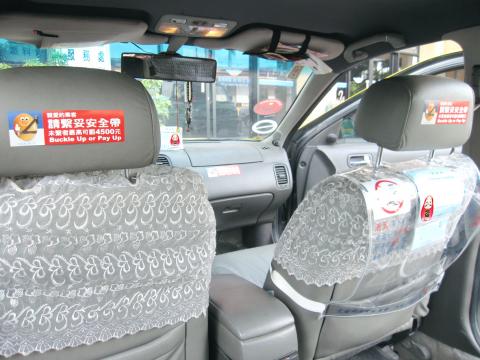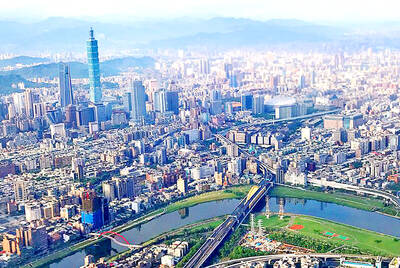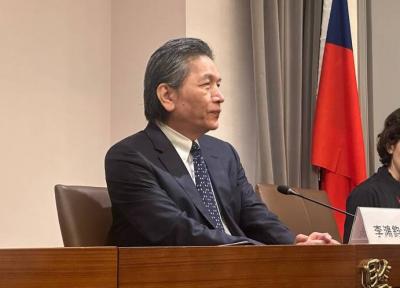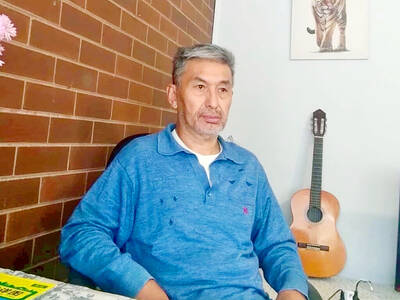The Directorate-General of Highways introduced a sticker yesterday that puts the onus on passengers sitting in back seats of taxis to fasten their seat belts or pay a fine.
According to a new law that took effect on Aug. 1, taxi drivers will be fined between NT$1,500 and NT$6,000 if their rear seat passengers are found not wearing seat belts and they were not informed before their ride of the necessity of using a seat belt.
There is a grace period — until Feb. 1 next year — before violators are penalized.

Photo: CNA, Directorate General of Highways
However, if passengers are informed by the driver to buckle up, but they decide not to, then the passengers would face a fine of NT$4,500, the agency said.
The new stickers, which read “Buckle Up or Pay Up,” were designed primarily to put the responsibility of wearing a seat belt when riding in taxis in the hands of the passenger.
The agency is recommending that taxi drivers adhere the stickers to the paneling facing the front passenger’s seat, as well as on the back of the front-seat headrests so they can be easily spotted.
By placing the stickers in those places, the drivers would meet their responsibility to inform the passengers of the law, the agency said.
The issue of wearing seat belts in the backseat gained national attention when Nora Sun (孫穗芬), a granddaughter of Republic of China founding father Sun Yat-sen (孫逸仙), was killed in a freeway car accident in January. She was not wearing a seat belt at the time of the crash.
Former Democratic Progressive Party lawmaker Chen Chao-lung (陳朝龍) first proposed the amendment to the Act Governing Punishments for Violations of Road Traffic Regulations (道路交通管理處罰條例) in 2006 after Shaw Hsiao-ling (邵曉鈴), the wife of Taichung Mayor Jason Hu (胡志強) was severly injured in a crash on a freeway near Tainan.
Shaw, who had not been wearing a seat belt, was thrown from a minivan, and lost her spleen and part of her left arm as a result of the accident.

Taipei has once again made it to the top 100 in Oxford Economics’ Global Cities Index 2025 report, moving up five places from last year to 60. The annual index, which was published last month, evaluated 1,000 of the most populated metropolises based on five indices — economics, human capital, quality of life, environment and governance. New York maintained its top spot this year, placing first in the economics index thanks to the strength of its vibrant financial industry and economic stability. Taipei ranked 263rd in economics, 44th in human capital, 15th in quality of life, 284th for environment and 75th in governance,

The Sports Administration yesterday demanded an apology from the national table tennis association for barring 17-year-old Yeh Yi-tian (葉伊恬) from competing in the upcoming World Table Tennis (WTT) United States Smash tournament in Las Vegas this July. The sports agency said in a statement that the Chinese Taipei Table Tennis Association (CTTTA) must explain to the public why it withdrew Yeh from the WTT tournament in Las Vegas. The sports agency said it contacted the association to express its disapproval of the decision-making process after receiving a complaint from Yeh’s coach, Chuang

Control Yuan Secretary-General Lee Chun-yi (李俊俋) tendered his resignation last night, admitting that he had misused a government vehicle, as reported by media. His resignation was immediately accepted by the Control Yuan. In a statement explaining why he had resigned, Lee apologized for using a Control Yuan vehicle to transport his dog to a pet grooming salon on May 20. The issue first came to light late last month, when TVBS News reported that Lee had instructed his driver to take the dog to the salon. The news channel broadcast photos that it said were taken by an unnamed whistle-blower, which purportedly showed the

A former officer in China’s People’s Liberation Army (PLA) who witnessed the aftermath of the 1989 Tiananmen Square massacre has warned that Taiwan could face a similar fate if China attempts to unify the country by force. Li Xiaoming (李曉明), who was deployed to Beijing as a junior officer during the crackdown, said Taiwanese people should study the massacre carefully, because it offers a glimpse of what Beijing is willing to do to suppress dissent. “What happened in Tiananmen Square could happen in Taiwan too,” Li told CNA in a May 22 interview, ahead of the massacre’s 36th anniversary. “If Taiwanese students or